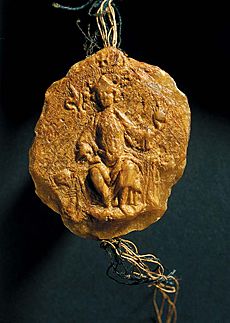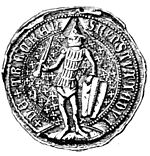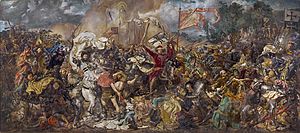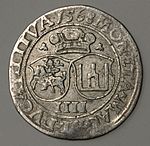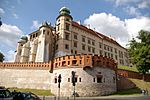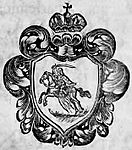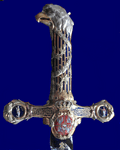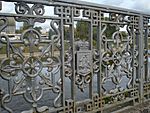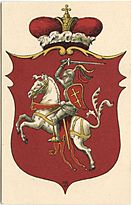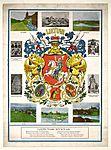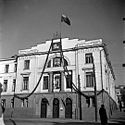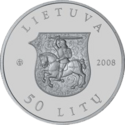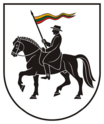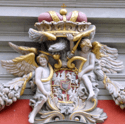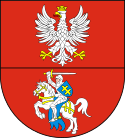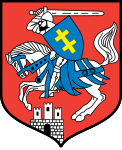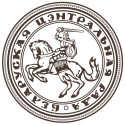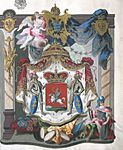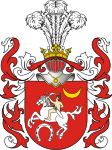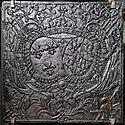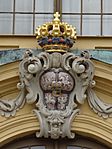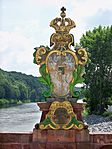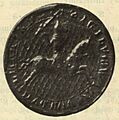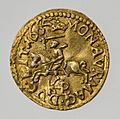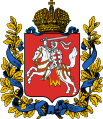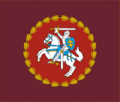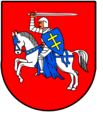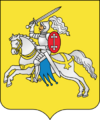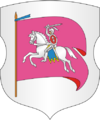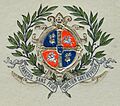Coat of arms of Lithuania facts for kids
Quick facts for kids Coat of arms of LithuaniaLietuvos herbas Vytis (Pogonia, Pahonia) |
|
|---|---|
 |
|
| Armiger | Grand Duchy of Lithuania, Republic of Lithuania |
| Adopted | First documented in 1366. Current version official since 1991. |
| Blazon | Gules, an armoured knight armed cap-à-pie mounted on a horse salient holding in his dexter hand a sword Argent above his head. A shield Azure hangs on the sinister shoulder charged with a double cross (Cross of Lorraine) Or. The horse saddles, straps, and belts Azure. The hilt of the sword and the fastening of the sheath, the stirrups, the curb bits of the bridle, the horseshoes, as well as the decoration of the harness, all Or. |
| Earlier version(s) | see below |
The coat of arms of Lithuania shows a knight on a horse, holding a sword and a shield. This symbol is called Vytis (pronounced 'vee-tis'). It has been Lithuania's official coat of arms since the early 1400s. It is one of the oldest coats of arms in Europe.
The word Vytis can mean "Chase," "Pursuer," "Knight," or "Horseman." It's similar to the Slavic word "vityaz," which means a brave warrior. Historically, it meant a "mounted epic hero" or a "mounted ruler."
Lithuania was once a very large and powerful state. It started as a duchy, then a kingdom, and finally a Grand Duchy. The Lithuanians, who were originally pagan, created this state. They did this to protect themselves from groups like the Teutonic Order. These groups were conquering nearby lands and forcing people to become Christian. Lithuanians were the only Baltic people to create their own state before modern times.
Lithuania also expanded its lands to the east. It conquered parts of what are now Belarus, Ukraine, and Russia. The galloping horseman on the coat of arms showed this powerful and expanding Lithuania. By 1588, the Vytis was even required on every county's official seal.
The ruling Gediminid family first used the horseback knight as their family symbol. Later, in the early 1400s, Grand Duke Vytautas the Great made the mounted knight on a red background the official coat of arms for the Grand Duchy of Lithuania. Since then, Lithuanian rulers and nobles used this coat of arms. The knight's shield often had the Columns of Gediminas or the Jagiellonian Double Cross. Today, Lithuania's Constitution says the state's coat of arms is "a white Vytis on a red field."
Contents
What the Coat of Arms Looks Like
The shield of the coat of arms is red (called gules in heraldry). It shows an armored knight on a silver (argent) horse. The horse is rearing up, ready to move. The knight holds a silver sword above his head.
On the knight's left shoulder, there is a blue (azure) shield. This shield has a gold (or) double cross on it. The horse's saddle, straps, and belts are blue. The sword's hilt, stirrups, bridle parts, and horseshoes are all gold. The decorations on the horse's harness are also gold.
| Different Versions Used by Institutions | |||||
|---|---|---|---|---|---|
 |
 |
 |
 |
 |
 |
| President | Seimas (Parliament) | Ministry of Agriculture | Ministry of the Interior | Police | Ministry of National Defence |
History of the Vytis
Early coats of arms often showed a knight on horseback. This knight was usually ready to defend himself. We don't know for sure what Lithuania's coat of arms was called at first.
Names of the Coat of Arms
The name Vytis for the Lithuanian coat of arms became popular later. In 1846, a historian named Simonas Daukantas used the term vytis to describe the knight, not the coat of arms itself. The word might come from the Lithuanian verb vyti ("to chase"). It could also be related to the Slavic word "vityaz" (brave warrior).
In the 1600s, a dictionary translated the Polish word Pogonia (meaning "chasing") into Lithuanian as Waykimas. This Waykimas (now spelled Vaikymas) is thought to be the oldest known Lithuanian name for the coat of arms.
The name Vytis became official in independent Lithuania. In Polish and Belarusian languages, the coat of arms is known as Pogoń or Pahonia, which also means "pursuit" or "chase."
Possible Early Ideas
Some people believe the Lithuanian horseman might represent Perkūnas. Perkūnas was the god of thunder, lightning, and war in Lithuanian mythology. He was seen as a protector. Ancient Lithuanians had amulets with horsemen from the 10th-11th centuries. This suggests the idea of a horseman warrior was important long ago.
The bright rider on a white horse might symbolize the spirit of an ancient warrior. This warrior would remind people of their values and give them strength. White horses were also special to the Baltic people.
Symbols of Early Rulers (Before 1400)
Early Lithuanian noble families used different symbols. These were often lines or arrows inside shields. They were passed down through generations.
The Lithuanian Chronicles mention that Grand Duke Narimantas (late 1200s) was the first to use a knight on horseback as his symbol. It described an armed man on a white horse, on a red field, with a sword raised. The author said it looked like he was chasing someone.
Symbols of Mindaugas
We don't know much about the symbols used by Lithuania's first rulers. One of the few surviving items is the seal of Mindaugas. Mindaugas united several Lithuanian tribes and became King of Lithuania in 1253. His seal from 1255 had an inscription: "Mindaugas, by the grace of God, King of Lithuania."
After Mindaugas's death, there was a time of disorder. Stability returned with Traidenis's rule around 1270. We don't know his symbols. However, old findings in Kernavė, an ancient capital, show many symbols. These include plants, flowers, and sun symbols, like swastikas. These date back to the pagan period before Lithuania became Christian.
Symbols of Gediminas
No original symbols of Grand Duke Gediminas have survived. A copy of his letters from 1323 describes his oval seal. It had a man with long hair sitting on a throne. He held a crown in one hand and a scepter in the other. There was also a cross around him and Gediminas's title in Latin.
Symbols on Coins of Vytautas and Jogaila
A unique symbol of a spearhead with a cross appeared on coins in the late 1300s. These coins are linked to Jogaila and Vytautas the Great.
Some rare Lithuanian coins from the 1300s show a lion or leopards with the Columns of Gediminas. These coins were minted when Smolensk was a vassal state of Vytautas the Great. The leopards had lily-shaped tails, which symbolized a sovereign ruler.
After Lithuania became Christian around 1388, Grand Duke Jogaila minted new coins. They had a fish rolled into a ring (a Christian symbol) and his name. The other side had the Double Cross of the Jagiellonians. This showed that Lithuania was now a Catholic state. Lithuania was the last country in Europe to become Christian.
Knight on Horseback
The coat of arms of Lithuania comes from pictures of rulers on their seals. The riding horseman first symbolized the ruler of the Duchy of Vilnius. This was the most important part of the state.
Algirdas was probably the first ruler to use a seal with himself on horseback. The oldest surviving seal with a horseman is Jogaila's from 1377-1380. The seal of Duke Vygantas from 1388 is the oldest with a riding knight on a shield, making it a coat of arms.
The knight on horseback became popular because of the importance of knighthood in Europe. At first, the knight might hold a lance instead of a sword. The direction the knight rode also varied. Later, Vytautas the Great also adopted the riding knight image.
The sword became important in the symbols of the Gediminid family. In 1386, after Jogaila became King of Poland, a new seal was made. It had four symbols: the Polish Eagle, the Lithuanian knight with a lance and a Double Cross on his shield, and symbols for other lands. This was the first time the Double Cross appeared on the Lithuanian horseman's shield. Jogaila adopted the Double Cross after his baptism and marriage to Queen Jadwiga of Poland. It likely came from the Kingdom of Hungary. This cross symbolized baptism and his new faith.
Columns of Gediminas
The Columns of Gediminas are another old national symbol of Lithuania. Some historians think they represent the gates of Trakai Peninsula Castle. There's no proof Gediminas himself used them. Their name likely came from him being seen as the founder of the Gediminid family.
Since 1397, the Columns were used on Vytautas the Great's coat of arms. They might have been used by his father Kęstutis too. At first, the Columns represented Kęstutis's family. By the 1500s, they became a symbol for all Gediminids.
The Columns of Gediminas were usually gold or yellow on a red background. Sometimes they were silver or white. They are definitely from Lithuania, as similar symbols are found on Lithuanian noble insignias. They might have come from signs used to mark property.
The Columns of Gediminas were used more often than the Jagiellonian Double Cross in the Grand Duchy of Lithuania. They appeared on coins, flags at the Battle of Grunwald, church items, and seals. They were even on cannon barrels. After the last male Gediminid died in 1572, the Columns remained a secondary state symbol.
Official Coat of Arms of the Grand Duchy of Lithuania
15th Century
Grand Duke Vytautas the Great made the horseman the official coat of arms of the Lithuanian state. Around 1382, he changed his family symbol from a standing warrior to a horseman. In his grand seal, he held a sword (for power) and a shield with a horseman (for the state). He also minted coins with the horseman on one side and the Columns of Gediminas on the other.
In 1410, at the Battle of Grunwald, Vytautas's regiments used red flags. Thirty of these flags had an armored horseman with a raised sword. The other ten had the Columns of Gediminas. These flags were named after different lands or dukes.
By the end of the 1300s, the knight on horseback appeared on the first Lithuanian coins. The image was still developing. Sometimes the knight rode left, sometimes right. He might hold a spear or a sword. The horse could be standing or galloping.
By the early 1400s, the colors and design of the seal became standard. It was a white (silver) charging knight on a red background. He had a sword raised and a blue shield with a gold Double Cross. The horse's bridles and belts were blue. Red symbolized courage and life. Blue symbolized spiritual values and wisdom.
- Coats of arms of the Grand Duchy of Lithuania in the 15th century
-
Seal of Sigismund Kęstutaitis with Vytis, 15th century.
-
The Royal Seal of Supreme Duke Władysław III Jagiellon, 1438.
-
Lithuanian coin of Grand Duke Casimir IV Jagiellon, 15th century.
During Grand Duke Alexander Jagiellon's rule (1492-1506), the knight's direction was set. The horse always galloped to the left (heraldic right). The knight also got a scabbard for his sword. The horse got a harness.
During Grand Duke Sigismund I the Old's rule (1506-1544), the horseman moved to the back of the coins. This showed it was a coin of the Grand Duchy of Lithuania. The knight also got a shield with the Jagiellonian Double-Cross. This image of the horseman became linked only to the Lithuanian state.
16th Century
In the 1500s, the idea of a separate ruler and state appeared. Before, they were seen as the same. In 1578, a historian described the state flag of the Grand Duchy of Lithuania. It was red silk with a white mounted knight. The other side had an image of the Blessed Virgin Mary. She was considered the patron saint of Lithuania.
After the Union of Lublin in 1569, the Polish-Lithuanian Commonwealth was formed. It had a combined coat of arms. But the Grand Duchy of Lithuania remained a separate state. Its army still used the Lithuanian coat of arms. The colors of the Lithuanian coat of arms started to change slightly, perhaps influenced by Polish colors.
In 1588, the Third Statute of Lithuania was adopted. It said that each county must use seals with the Lithuanian coat of arms. The county's name had to be on the seal.
After Grand Duke Sigismund II Augustus died in 1572, the Double Cross remained a national symbol. It was then called the Cross of Vytis, no longer just linked to the Jagiellonian family.
- 16th-century depictions of the Lithuanian coats of arms
-
Tapestry with the coat of arms of Grand Duke Sigismund II Augustus, circa 1548.
17th Century to 1795
The Renaissance brought small style changes to the Vytis. The knight's helmet got long feathers. The horse's saddle-cloth became long. The horse's tail turned upwards. This red flag with its white knight was used until the late 1700s.
Grand Duke Stanislaus II Augustus was the last to use it. His flag was crimson with two tails. It had the knight on one side and his initials on the other. In 1795, after the Polish-Lithuanian Commonwealth was divided, Lithuania was taken over by the Russian Empire. The traditional coat of arms was removed.
- 17th-century coats of arms of the Grand Duchy of Lithuania
-
Coat of arms of the Polish–Lithuanian Commonwealth.
-
Coin of 15 golden Ducats of Grand Duke Sigismund III Vasa, 1617.
-
Coin of Grand Duke John III Sobieski, 1684.
- 18th-century Lithuanian coats of arms
-
Coin of Grand Duke Augustus II the Strong, 1702.
-
Coin of 10 golden Ducats of Grand Duke Augustus III, 1756.
Vytis from 1795 to 1918
At first, the charging knight was seen as the country's ruler. Later, he became a knight chasing invaders out of his homeland. This idea was very popular in the 1800s and early 1900s. During this time, Lithuania was part of the Russian Empire and wanted its independence.
During the Lithuanian National Revival in the 1800s, Lithuanian thinkers said that the new Lithuanian nation was the heir to the Grand Duchy of Lithuania's heritage. This included the Vytis coat of arms.
19th-Century Uprisings
The Vytis was used as a symbol of rebellion against the Russian Empire. This happened during uprisings to restore the Polish-Lithuanian Commonwealth, like the November Uprising (1830–31) and the January Uprising (1863–64). The Lithuanian Vytis was widely used with the Polish White Eagle on flags, coins, and other items.
- Lithuanian coats of arms during the Uprisings of 1830–1831 and 1863–1864
-
Relics of the November Uprising, in Vilnius.
-
Coat of arms of the November Uprising, 1830–31.
-
Emblem of the January Uprising, 1863–64.
The January Uprising spread widely in Lithuanian lands. Many rebels wanted a fully independent Lithuanian state. However, most Lithuanians supported the Polish-Lithuanian union to fight Russian rule more effectively.
In the Russian Empire (1795–1915)
After the Polish-Lithuanian Commonwealth was divided, most of Lithuania became part of the Russian Empire. The Vytis was then included in the larger Coat of arms of the Russian Empire. The Vytis was also the coat of arms for the Vilna Governorate.
Statues of Vytis stood on the White Columns of Vilnius from 1818 to 1840. They were then replaced with the Russian double-headed eagles. Some original Lithuanian coats of arms survived the occupations. You can still see them on the Vilnius Cathedral and the Gate of Dawn.
In 1845, Tsar Nicholas I approved a coat of arms for the Vilna Governorate that looked like the historical one. A key change was replacing the Jagiellonian Double-Cross with a Patriarchal cross on the knight's shield.
- Use of the Lithuanian coats of arms in the Russian Empire
-
Seal of the City of Vilnius, 19th century.
In 1905, the Great Seimas of Vilnius met. They decided to demand more self-rule for Lithuania within the Russian Empire. It was suggested to use the Grand Duchy of Lithuania's flag (a white horse rider on a red background) as Lithuania's flag. But this idea was rejected because the red color was linked to the 1905 Russian Revolution.
1915–1918
Discussions about the national flag continued during World War I. After Germany occupied Lithuania in 1915, Lithuanians formed groups to plan for their statehood. They discussed national colors and the national flag.
In 1917, a meeting of Lithuanian intellectuals took place. Jonas Basanavičius said that the old Lithuanian flag was red with a dapple-grey horseman. He suggested using this for the new Lithuanian state. No one disagreed, but they realized a red flag without the Vytis couldn't be used.
They decided to choose colors found in traditional folk items, like ribbons. Green and red were common. Artist Antanas Žmuidzinavičius was asked to combine these colors. Another artist, Tadas Daugirdas, suggested adding a narrow yellow line between green and red. Yellow symbolized dawn and rebirth.
On February 16, 1918, the Council of Lithuania declared Lithuania's independence. They adopted Vytis as its coat of arms. Early designs were by Tadas Daugirdas and Antanas Žmuidzinavičius. On April 19, 1918, a flag with three equal horizontal lines of yellow, green, and red was accepted. This became the Flag of the State of Lithuania.
After Soviet Russia occupied Vilnius in 1919, Lithuanian institutions moved to Kaunas. In Kaunas, the historical flag of Lithuania was raised. This flag had a white horseman on a red background on one side. It had the Columns of Gediminas on the other.
Republic of Lithuania in the Interwar Period
"What is the ideal of our nation? It is written on the symbol of our state, passed down from ancient times. Other nations have lions, or other symbols of power in their flags. It is beautiful, it is grand! We have Vytis, an armored horseman on a horse with a sword in his hand, galloping forward. It is beautiful, it is noble! He, as told in old writings, was praised by the Vaidilas [a priest in the Baltic religion], sung by the singers. That symbol is the pride of our nation: a symbol of knightly justice. Let us never forget him, in our dealings with our own people or with other countries. As long as we are true to him, no one will defeat us. The knight is fair, but he wears armor and has a sword. When needed, he draws his sword and stands for justice against those who disrespect it. To show justice this way is to act not only like a statesman, but also like a true Lithuanian."
When Lithuania regained independence in 1918–1920, artists made new versions of the coat of arms. Most included a scabbard, which wasn't in the oldest versions. A popular version by Antanas Žemaitis showed the horse appearing to fly.
There was no single official version of the coat of arms. In 1929, a special group was formed to create an official state emblem. They looked at the best 16th-century examples of Vytis. Mstislav Dobuzhinsky was the main artist. Their design was never officially confirmed. However, a design by Juozas Zikaras was used on Lithuanian coins.
The Columns of Gediminas and the Jagiellonian Double Cross were widely used after Lithuania regained independence in 1918. These symbols were adopted by the Lithuanian Land Forces, Lithuanian Air Force, and other public groups. They decorated coins, banknotes, awards, and medals.
In 1919, the Double Cross of the Jagiellonians was named the Cross for Homeland. It was on one of Lithuania's highest awards, the Order of the Cross of Vytis. This award was given for bravery in defending Lithuania's freedom. In 1928, the Order of the Lithuanian Grand Duke Gediminas was created. It was given for great service to the state.
The Vytis was Lithuania's state symbol until 1940. That year, the Soviet Union occupied Lithuania. National symbols were banned, and displaying them led to harsh punishments. When the Soviet Union broke up, the Vytis, Columns of Gediminas, and the national flag became symbols of Lithuania's independence movement. In 1988, Soviet authorities in Lithuania allowed the public display of Vytis.
- Coats of arms of the Republic of Lithuania in the interwar period
-
A design of Vytis by Antanas Žmuidzinavičius.
-
A banknote of 10 Lithuanian litas with Vytis, 1927.
-
A banknote of 5 Lithuanian litas with Vytautas the Great and Vytis, 1929.
-
A Lithuanian bomber ANBO VIII with the Double Cross, 1939.
Republic of Lithuania in the Post-Cold War Era
On March 11, 1990, Lithuania declared its independence. It brought back all its national symbols from before the war, including the historic Vytis coat of arms. On March 20, 1990, the Supreme Council of Lithuania approved the description of the State's coat of arms. The design was based on Juozas Zikaras's version. This showed that Lithuania was continuing the traditions of the state that existed from 1918 to 1940.
On September 4, 1991, a new design by Arvydas Každailis was approved. It went back to the look of the Grand Duchy of Lithuania. It brought back the original colors (red, blue, silver, and gold) from Vytautas the Great's time. The horse and rider were shown in a more "defensive" pose. This showed that the Republic of Lithuania was a heir to both the independent state of 1918–40 and the Grand Duchy of Lithuania. The Constitution of the Republic of Lithuania states that the Coat of Arms is a white Vytis on a red field.
The Lithuanian coat of arms is widely used by the Lithuanian Armed Forces on uniforms, badges, and flags.
In 2004, Lithuania's Seimas (parliament) approved a new version of the Vytis for the historical flag of Lithuania. This flag is red and looks like the old battle flags. It is used on special occasions and at historical buildings. It does not replace the yellow-green-red national flag.
There is a proposal to adopt a larger version of the coat of arms. It would include a line from the national anthem: "Vienybė težydi" ("May unity blossom"). The Seimas already uses a larger version with this motto. It has two supporters: a silver griffin and a silver unicorn. It also has a ducal hat on top of the shield.
The President of Lithuania uses a circular seal and document forms with the coat of arms. The seal says "Lietuvos Respublikos Prezidentas" (President of the Republic of Lithuania).
Lithuania joined the Eurozone in 2015. The Lithuanian euro coins have the Vytis and the country's name, Lietuva, on them. The horse is shown leaping forward, like in older versions.
In 2018, the Kaunas Castle unveiled the Freedom Warrior monument. It shows a graphical representation of Vytis.
- Coats of arms of the Republic of Lithuania in the Post-Cold War era
-
Litas commemorative coin with a historical Vytis.
-
A banknote of 500 Lithuanian litas with Vytis, 2000.
-
A coin of 1 Lithuanian Euro with Vytis, 2015.
Related and Similar Coats of Arms
Lithuania
Several towns and counties in Lithuania use symbols similar to Vytis. For example, the coat of arms of Liudvinavas shows Vytis on one side and Lady Justice on the other.
- Coats of arms of Lithuanian counties, cities, and towns with a horseman
-
Vilnius County coat of arms.
-
Panevėžys County coat of arms.
Poland
Lithuania and Poland were closely connected for centuries, especially during the Polish–Lithuanian Commonwealth. Because of this, the Lithuanian coat of arms also appeared in Poland.
- Usage of ''{{lang|lt|Vytis}}'' (''{{lang|pl|Pogonia}}'') in Poland
-
John III Sobieski's coat of arms in Gdańsk.
-
Vytis on the Jagiellonian University in Kraków.
-
Coat of arms of John I Albert.
-
Guardhouse, Poznań, 1780s.
-
Podlaskie Voivodeship coat of arms.
-
Byalistok coat of arms.
Belarus
The lands of Belarus were part of the Grand Duchy of Lithuania for a long time. So, the Lithuanian coat of arms became part of their local symbols. Belarusian nationalists adopted Lithuania's coat of arms as their national emblem in 1918. This Belarusian coat of arms is called Pahonia (Пагоня), meaning "the chase."
The Belarusian Pahonia is similar to the Lithuanian Vytis. It also shows an armed white horseman on a red background. However, the cross on the Belarusian knight's shield has uneven bars. The horse's tail points down, and there is no blue color.
Pahonia was chosen as the state emblem for the short-lived Belarusian Democratic Republic. It was used by Belarusian military units and organizations abroad. During the Soviet period, the Pahonia coat of arms was banned. People who had it could be imprisoned.
In 1991, when Belarus became independent, the white–red–white flag and Pahonia were adopted again. But after the 1994 presidential election, Belarus voted to use a modified version of the Soviet flag and emblem. This was done in a 1995 vote. However, Pahonia is still used by the Belarusian opposition. It became very popular during the 2020–2021 Belarusian protests.
- Usage of ''{{lang|lt|Vytis}}'' (''{{lang|be-Latn|Pahonia}}'') in Belarus
-
Coat of arms of Mahilyow.
Ukraine
The horseman was also seen on the coat of arms of the Kingdom of Galicia–Volhynia. It was on the seal of King Yuri II Boleslav and in proposals for the coat of arms of the Ukrainian People's Republic.
- Coats of arms in Ukraine which features a horseman
-
Coats of arms of the Kingdom of Galicia–Volhynia, 1313.
-
Seal of King Yuri II Boleslav, 14th century.
-
Coat of arms of Švitrigaila, circa 1440.
-
Watch tower of Vytautas the Great in Kherson Oblast.
-
Mykhailo Hrushevskyi's proposal for the coat of arms of the Ukrainian People's Republic.
-
Coat of arms of Zhytomyr Oblast.
Russia
Some Russian regions have adopted Lithuanian coats of arms. This is due to their historical links with the Grand Duchy of Lithuania. These symbols were restored after the Soviet Union broke up.
- Usage of ''{{lang|lt|Vytis}}'' (''{{transliteration|ru|Pogonya}}'') in Russia
Noble Families
| Pogoń Litewska | |
|---|---|
| Alternative name(s) | Pogoń Litewska Książęca |
| Families |
57 names
Aczkiewicz, Algiminowicz, Algminowicz, Alkimowicz, Biciutek, Byciutek, Boremlski, Boremski, Chowanski, Czartoryski, Dowmont, Dulski, Hurko, Gediminids, Izasławski, Izopolski, Klajowski, Kobryński, Konierewicz, Kopylski, Korecki, Korjatowicz, Koryatowicz, Koszerski, Koszyrski, Kowelski, Kurakin, Krzywicki, Krzywiecki, Krzywięcki, Lingwieniewicz, Litwinowicz, Łukomlski, Mackiewicz, Morski, Możarowski – Możajski, Mścisławski, Niedzielski, Nowosielski, Olelkowicz, Olgierd, Plusko, Pluszkow, Pokłoński, Postawka, Radzikiewicz, Rybicki, Sakalauskas, Sanguszko, Słucki, Sudwoj, Świderski, Trubecki, Wandza, Worotyniec, Zasławski |
| Cities | Puławy |
| Divisions | Puławy County |
The Lithuanian coat of arms, with some changes, was adopted by several noble families. These included Lithuanian, Polish, and Russian noble families like Czartoryski, Sanguszko, and Trubetskoy. In Polish heraldry, these coats of arms are called Pogoń Litewska.
Other Locations
Austria
- Vytis in Austria
-
Albertina, Vienna, 18th century.
France
- Vytis in France
-
Catholic church, Nancy, 18th century.
-
Vytis on top of Palais de la Cité's clock, Paris, since 1585.
-
Vytis in the Lorraine Museum.
-
Grave of Marie Leszczyńska in Saint-Denis.
Latvia
- Vytis in Latvia
-
Coin of the Duchy of Courland and Semigallia, 1578.
Sweden
- Vytis in Sweden
-
Banner of Sigismund III Vasa in Stockholm.
Germany
- Vytis in Germany
-
Zwinger, Dresden, 18th century.
-
Coats of arms on the Theatine Church in Munich.
-
Coats of arms on the Saxon milepost in Grimma.
-
Portal of a post office in Wurzen, 1734.
-
Vytis in Bavaria.
Images for kids
-
Baltic mythology pagan Gods: Peckols, Perkūnas, Potrimpo
-
Lithuanian Denar of Jogaila with a lion, 1386–1387.
-
Vytautas the Great's denar with a cross, spearhead (or crossbow bolt) and the Columns of Gediminas, 1413–1430.
-
Lithuanian Denar of Jogaila with horseman, minted in the 14th century.
-
Duke Sigismund Korybut and his troops flying the Lithuanian banner of arms in Prague, 15th century.
-
Seal of Sigismund Kęstutaitis with Vytis, 15th century.
-
The Royal Seal of Supreme Duke Władysław III Jagiellon, 1438.
-
Lithuanian Denar of Grand Duke Casimir IV Jagiellon, 15th century.
-
The first page of the Latin copy of Laurentius (1531) of the First Statute of Lithuania.
-
Tapestry with the coat of arms of Grand Duke Sigismund II Augustus, circa 1548.
-
Coat of arms of the Polish–Lithuanian Commonwealth.
-
Coin of 15 golden Ducats of Grand Duke Sigismund III Vasa, 1617.
-
Golden Lithuanian Ducat of Grand Duke John II Casimir Vasa, 1665.
-
Coin of Grand Duke John III Sobieski, 1684.
-
Thaler of Grand Duke Augustus II the Strong, 1702.
-
Coin of 10 golden Ducats of Grand Duke Augustus III, 1756.
-
Relics of the Uprising of 1831, in the National Museum of Lithuania.
-
Coat of arms of the November Uprising, 1830–31.
-
The Provisional Government in Warsaw reintroduced Vytis and Eagle on the coins and banknotes, 1830–31.
-
Emblem of the January Uprising, 1863–64.
-
Coat of arms of Lutsin from 1781.
-
Coat of arms of Mogilev from 1781.
-
Coat of arms of Rezhitsa from 1781.
-
Coat of arms of Vitebsk from 1781.
-
Coat of arms of Dünaburg, 1843.
-
Presidential Seal of the Republic of Lithuania with Vytis, 1919–1940.
-
A design of Vytis by Antanas Žmuidzinavičius.
-
A banknote of 10 Lithuanian litas with Vytis, 1927.
-
A banknote of 5 Lithuanian litas with Vytautas the Great and Vytis, 1929.
-
A Lithuanian bomber-reconnaissance monoplane ANBO VIII.
-
Litas commemorative coin.
-
A banknote of 500 Lithuanian litas with Vytis, 2000.
-
A coin of 1 Lithuanian Euro with Vytis, 2015.
-
Vilnius County coat of arms.
-
Panevėžys County coat of arms.
-
John III Sobieski's coat of arms crowning the Royal Chapel in Gdańsk.
-
Vytis on the façade of the Collegium Novum of the Jagiellonian University in Kraków.
-
Illustration with coat of arms of John I Albert.
-
Guardhouse, Poznań, 1780s.
-
Podlaskie Voivodeship coat of arms.
-
Byalistok coat of arms.
-
The Pahonia as used in the Belarusian People's Republic in 1918.
-
Coat of arms of Mahilyow.
-
Coats of arms of the Kingdom of Galicia–Volhynia, 1313.
-
Seal of King Yuri II Boleslav, 14th century.
-
Coat of arms with Vytis of Švitrigaila, circa 1440.
-
Watch tower of Vytautas the Great in Kherson Oblast.
-
Mykhailo Hrushevskyi's proposal for the coat of arms of the Ukrainian People's Republic.
-
Coat of arms of Zhytomyr Oblast.
-
Albertina, Vienna, 18th century.
-
Catholic church, Nancy, 18th century.
-
Vytis on top of Palais de la Cité's clock, Paris, since 1585.
-
Vytis in the Lorraine Museum.
-
Grave of Marie Leszczyńska in Saint-Denis.
-
Double-Denar of the Duchy of Courland and Semigallia, 1578.
-
Banner of Sigismund III Vasa in Stockholm.
-
Freiberg Cathedral in Freiberg, Saxony, 18th century.
-
Zwinger, Dresden, 18th century.
-
Coats of arms on the Theatine Church in Munich.
-
Coats of arms on the Saxon milepost in Grimma.
-
Portal of a post office in Wurzen, 1734.
-
Vytis in Bavaria.
See also
 In Spanish: Escudo de Lituania para niños
In Spanish: Escudo de Lituania para niños
- Emblem of the Lithuanian Soviet Socialist Republic
- Armorial of Lithuania



